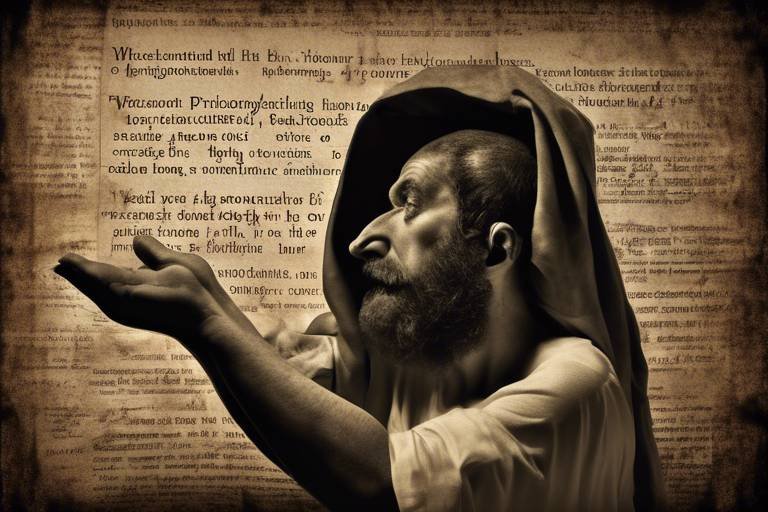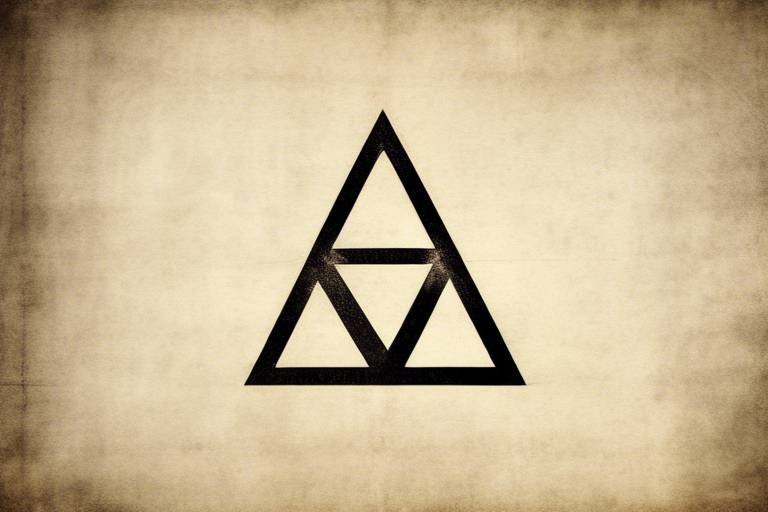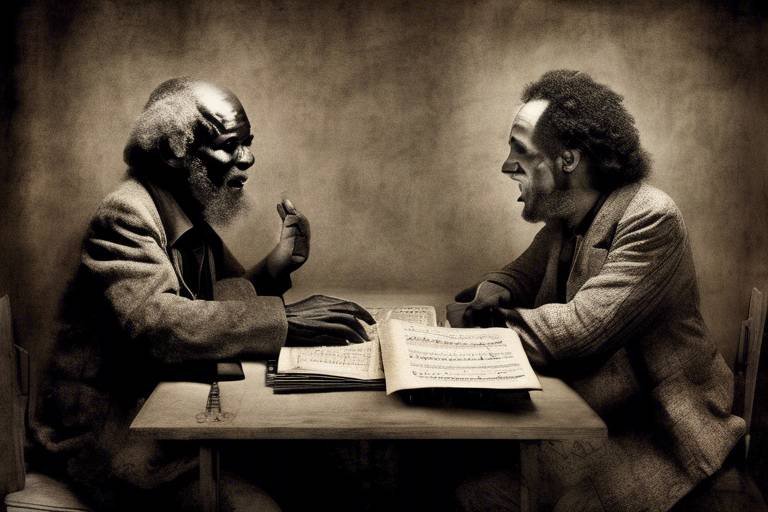Plato's Allegory of the Cave: A Philosophical Evaluation
Plato's Allegory of the Cave is not just a story; it’s a profound philosophical exploration that resonates through the ages. Imagine being trapped in a dark cave, where the only reality you know is the flickering shadows cast on the wall in front of you. This chilling metaphor invites us to question our perceptions of reality and challenges us to seek the truth beyond mere appearances. In this article, we will delve into the intricacies of this allegory, examining its themes, implications, and its relevance in contemporary philosophy. The allegory serves as a mirror reflecting our own struggles with knowledge and ignorance, pushing us toward a deeper understanding of enlightenment.
At its core, Plato's Allegory of the Cave presents a narrative that is both simple and complex. It begins with prisoners who have been chained inside a cave for their entire lives, facing a blank wall. Behind them, a fire burns, and between the fire and the prisoners is a walkway where puppeteers can cast shadows on the wall. These shadows are all the prisoners know of reality. They believe these shadows are the entirety of existence, unaware of the world outside the cave. When one prisoner escapes and discovers the outside world, he experiences the blinding light of the sun, representing the ultimate truth and knowledge. This journey from darkness to light symbolizes the philosophical journey toward enlightenment and the struggle to grasp the true nature of reality.
Plato's allegory raises profound questions about the nature of reality itself. It compels us to consider how our perceptions shape our understanding of the world around us. Are we merely observing shadows, or can we step into the light of true knowledge? This exploration leads us to ponder whether what we perceive is reality or merely a distorted reflection. The allegory suggests that most people live in ignorance, mistaking illusion for truth. This perspective invites us to challenge our own beliefs and assumptions, encouraging a deeper inquiry into what we accept as reality.
One of the most intriguing aspects of Plato's philosophy is his theory of Forms. According to Plato, the physical world is merely a shadow of a higher realm of ideal forms, which represent true knowledge. The allegory illustrates this distinction beautifully. The prisoners in the cave are akin to those who only see the shadows, while the escaped prisoner represents the philosopher who seeks to understand the Forms. This journey highlights the importance of transcending the physical world to access higher truths. In essence, the allegory serves as a reminder that what we perceive through our senses may not be the ultimate reality, urging us to seek a deeper understanding of existence.
In Plato's allegory, the role of the philosopher is crucial. The escaped prisoner, upon realizing the truth, feels a responsibility to return to the cave and enlighten the others. This act symbolizes the philosopher's duty to seek truth and guide others out of ignorance. However, this journey is fraught with challenges; the prisoners may resist the truth, preferring the comfort of their familiar shadows. This dynamic reflects the broader societal struggle between enlightenment and ignorance, showcasing the philosopher's role as both a seeker of knowledge and a teacher. The philosopher must navigate the delicate balance of revealing truths while respecting the comfort zones of those still in the cave.
The contrast between ignorance and knowledge is a central theme in the allegory. Plato uses the cave to illustrate the struggle humans face in their quest for understanding. The prisoners represent those who are content with superficial knowledge, while the escaped prisoner embodies the relentless pursuit of truth. This metaphor resonates deeply in our contemporary society, where misinformation and superficiality often cloud our judgment. The allegory challenges us to confront our own ignorance and strive for deeper insights. It emphasizes that the journey toward knowledge requires courage and resilience, as it often involves questioning long-held beliefs and confronting uncomfortable truths.
Focusing on the transformative journey of the escaped prisoner, we see a clear path toward enlightenment. Initially, the escapee struggles with the blinding light of the sun, symbolizing the discomfort that often accompanies the pursuit of knowledge. This journey consists of several stages, including:
- Awakening: The realization that there is more to reality than the shadows.
- Adjustment: Gradually adapting to the light and understanding the true forms.
- Return: The decision to share newfound knowledge with others, despite potential resistance.
This journey illustrates that enlightenment is not a one-time event but rather an ongoing process filled with challenges and revelations. Each stage requires introspection, courage, and a willingness to question the status quo.
Plato's Allegory of the Cave has significant implications for education. It emphasizes the importance of critical thinking and encourages students to look beyond mere appearances. Education should not simply be about memorizing facts; it should foster a deeper understanding of reality and promote inquiry. The allegory suggests that true education involves guiding individuals out of the cave of ignorance and into the light of knowledge.
Inspired by the allegory, educators can adopt various pedagogical approaches that prioritize inquiry and self-discovery. These methods may include:
- Socratic questioning: Encouraging students to ask questions and engage in dialogue.
- Experiential learning: Providing opportunities for hands-on experiences that challenge perceptions.
- Critical analysis: Teaching students to analyze and critique information rather than accept it at face value.
By fostering an environment that values exploration and questioning, educators can help students break free from the confines of ignorance and develop a more profound understanding of the world.
In today's educational landscape, Plato's ideas remain relevant. As we navigate an era marked by rapid information exchange and digital distractions, the need for critical engagement with knowledge is more important than ever. By promoting a curriculum that encourages students to question the status quo, we can empower the next generation to seek the truth beyond the shadows. Plato's allegory serves as a timeless reminder that education should be a journey toward enlightenment, guiding individuals to discover their own paths to knowledge.
- What is the main message of Plato's Allegory of the Cave?
The main message is that reality is often obscured by ignorance, and true knowledge requires a journey beyond mere appearances.
- How does the allegory relate to modern education?
The allegory emphasizes the importance of critical thinking and encourages educators to foster inquiry and self-discovery in students.
- What role do philosophers play in society according to Plato?
Philosophers are seen as seekers of truth who have a responsibility to guide others out of ignorance and toward enlightenment.

The Allegory Explained
Plato's Allegory of the Cave is a profound narrative that invites us to question our understanding of reality. Imagine a group of prisoners who have been chained inside a dark cave for their entire lives. They can only see the shadows cast on the wall in front of them, shadows created by objects passing in front of a fire behind them. This scenario serves as a powerful metaphor for human existence, where the shadows represent the illusions that we often mistake for reality.
In this allegory, the prisoners symbolize the general populace, who are unaware of the deeper truths of existence. The shadows they see are akin to the superficial knowledge that most individuals accept without question. When one prisoner is freed and steps outside the cave, he is initially blinded by the sunlight, representing the discomfort that often accompanies the pursuit of true knowledge. However, as his eyes adjust, he begins to see the world in its full brilliance, encountering the actual objects that cast the shadows he once perceived as reality.
This journey of enlightenment is not just a personal transformation; it serves as a commentary on the philosophical journey of all individuals. The cave represents our limited perception, while the outside world symbolizes the realm of true knowledge and understanding. Plato uses this allegory to illustrate that achieving enlightenment is not merely about acquiring information; it is about undergoing a profound transformation in how we perceive and understand the world around us.
Furthermore, the allegory emphasizes the responsibility of those who have achieved enlightenment. The freed prisoner, upon returning to the cave, is met with resistance and disbelief from the others. This reaction highlights a crucial theme: the struggle of enlightened individuals to share their newfound knowledge with those who remain in ignorance. It raises the question: how can one effectively communicate profound truths to those who are not yet ready or willing to understand?
In essence, Plato's Allegory of the Cave challenges us to reflect on our own lives. Are we merely watching the shadows on the wall, or are we brave enough to venture outside the cave and seek the light of understanding? The allegory serves as a timeless reminder of the importance of questioning our perceptions and striving for deeper insights into the nature of reality.

The Nature of Reality
The essence of reality is a complex tapestry woven from our perceptions, experiences, and the underlying truths that govern existence. Plato's Allegory of the Cave serves as a profound metaphor for this intricate relationship between perception and reality. Imagine a group of prisoners, shackled in a dark cave, only able to see shadows flickering on the wall before them. These shadows, mere reflections of objects passing in front of a fire behind them, represent the limited understanding of those who have never ventured beyond their immediate experiences. It raises a compelling question: how much of what we perceive is merely a shadow of the truth?
As we delve deeper into the allegory, we encounter the philosophical inquiries that arise from this scenario. The prisoners, confined to their chains, symbolize humanity's struggle to break free from ignorance. They are trapped in a world where their reality is dictated by the shadows, unable to grasp the more profound truths that lie beyond their perception. This leads us to ponder the nature of reality itself. Is reality simply what we can see and touch, or is there a deeper, more significant truth that exists beyond our senses?
Plato encourages us to question our assumptions about reality. The journey from the cave into the light represents the transformative process of acquiring knowledge. As one prisoner escapes and discovers the outside world, he is confronted with the vibrant colors, the warmth of the sun, and the vastness of reality that was previously unimaginable. This experience highlights the importance of enlightenment in understanding the true nature of existence. It compels us to consider that what we perceive with our senses may be just a fraction of what is truly out there.
In examining the nature of reality, we must also address the concept of the World of Forms. Plato posited that beyond our physical world lies a realm of ideal forms—perfect representations of concepts and objects that exist independently of our perception. This distinction is crucial, as it implies that our sensory experiences are often flawed interpretations of these ideal forms. For instance, consider how we perceive beauty: the beauty of a flower is a mere shadow of the perfect form of beauty that exists in the abstract. Thus, reality becomes a layered construct, where our understanding is continually shaped and reshaped by our experiences and the pursuit of deeper truths.
To illustrate this further, let's consider a simple table that contrasts the shadows in the cave with the ideal forms:
| Shadows (Perceived Reality) | Ideal Forms (True Reality) |
|---|---|
| Flawed interpretations of objects | Perfect representations of concepts |
| Dependent on sensory experiences | Independent of human perception |
| Temporary and changeable | Timeless and unchanging |
This table underscores the dichotomy between the superficial understanding of reality and the profound truths that lie beneath the surface. As we navigate through life, it becomes essential to strive for a deeper understanding, much like the escaped prisoner who, after experiencing the light, returns to the cave to enlighten others. This highlights the philosopher's role in society, as they seek to guide others toward the truth, challenging them to question their perceptions and pursue knowledge.
Ultimately, the nature of reality is a philosophical journey fraught with challenges and revelations. The allegory not only serves as a reflection of our own experiences but also as a call to action—to seek knowledge, to question our perceptions, and to strive for enlightenment. In a world where shadows often dominate our understanding, the pursuit of true reality becomes an essential endeavor for personal growth and collective enlightenment.
- What is the main message of Plato's Allegory of the Cave? The allegory illustrates the difference between the world of appearances and the world of reality, emphasizing the importance of seeking knowledge and enlightenment.
- How does the allegory relate to modern education? It highlights the need for critical thinking and encourages students to question and explore beyond superficial knowledge.
- What does the journey out of the cave symbolize? It represents the transformative process of gaining knowledge and understanding the deeper truths of existence.

The World of Forms
In the realm of philosophy, Plato's theory of Forms stands as a cornerstone of his thought, intricately woven into the fabric of the Allegory of the Cave. Imagine a world where everything you perceive is merely a shadow of a greater reality. This is the essence of the World of Forms, where the true nature of existence resides beyond the physical realm we experience daily. Plato posits that the tangible objects we encounter are mere imitations of these ideal Forms, which represent the highest level of truth and knowledge.
To grasp this concept, consider the analogy of a chair. The physical chair you sit on is subject to wear and tear, it may be made of different materials, and its design may vary. However, the ideal Form of a chair—what makes it a 'chair' in the purest sense—exists in a higher realm. It embodies the perfect qualities that define 'chairness.' This distinction between the imperfect, sensory world and the perfect, abstract world is crucial in understanding how Plato views knowledge and reality.
In Plato's allegory, the prisoners in the cave are limited to observing shadows on the wall, which represent the distorted perceptions of reality shaped by their environment. These shadows symbolize the physical manifestations of the Forms, where people are trapped in a cycle of misunderstanding. The journey out of the cave signifies the philosopher's quest to ascend from the shadows to the light of true knowledge, ultimately reaching the World of Forms.
Moreover, the World of Forms is not just an abstract notion; it has profound implications for how we perceive knowledge and truth. Plato argues that true knowledge is not derived from sensory experience but rather from intellectual insight into these Forms. This perspective challenges us to question the reliability of our perceptions and encourages a deeper inquiry into the essence of what we consider 'real.'
In summary, the World of Forms serves as a vital framework for understanding Plato's philosophical views. It compels us to reflect on our own experiences and the limitations of our perceptions. By recognizing that the physical world is just a shadow of a more profound reality, we can begin to appreciate the importance of seeking knowledge beyond mere appearances. This pursuit not only enriches our understanding but also empowers us to engage more meaningfully with the world around us.
- What is the significance of the World of Forms in Plato's philosophy? The World of Forms is essential as it distinguishes between the imperfect physical world and the perfect realm of ideal Forms, which represent true knowledge.
- How does the Allegory of the Cave illustrate the concept of Forms? The Allegory of the Cave depicts prisoners who perceive only shadows, symbolizing how people often see only the physical manifestations of the Forms, rather than the Forms themselves.
- Can we access the World of Forms? According to Plato, access to the World of Forms is achieved through philosophical reasoning and intellectual insight, allowing individuals to transcend mere sensory experience.

The Role of the Philosopher
In Plato's Allegory of the Cave, the figure of the philosopher emerges as a beacon of hope, a guide for those still trapped in the shadows of ignorance. Imagine a world where everyone is chained, watching mere reflections of reality on a wall, believing those shadows to be the entirety of existence. The philosopher, in this context, symbolizes the individual who has managed to break free from these chains and has ventured into the light of true understanding. This journey is not merely a personal triumph; it is a profound responsibility to return to the cave and enlighten others.
The role of the philosopher extends beyond mere intellectual curiosity; it involves a commitment to the pursuit of truth and the courage to challenge the status quo. Philosophers are tasked with questioning the conventional wisdom that often goes unchallenged. They are the ones who dare to ask, "What if?" and "Why not?" This relentless pursuit of knowledge is crucial in a society that often prefers comfort over confrontation. Just as the escaped prisoner struggles to adjust to the brightness of the outside world, philosophers face the daunting challenge of illuminating the minds of those who may resist change.
Furthermore, the philosopher's journey is characterized by several key responsibilities:
- Seeking Truth: Philosophers must continuously seek deeper understanding, going beyond the surface level of appearances.
- Guiding Others: They have a duty to guide those still in the cave, helping them realize the limitations of their perceptions.
- Encouraging Critical Thinking: Philosophers promote questioning and skepticism, fostering a culture of inquiry that challenges accepted norms.
- Advocating for Enlightenment: They must advocate for the importance of enlightenment, emphasizing that knowledge is not just power but a pathway to a more fulfilling life.
In essence, the philosopher in Plato's allegory is not just a thinker but a transformative figure. They embody the idea that knowledge is not a destination but a journey. As they navigate the complexities of reality, they invite others to join them on this path, encouraging a collective awakening to the truths that lie beyond the shadows. This role is particularly relevant today, as we face a world filled with misinformation and superficial understandings of complex issues. The philosopher's call to action is more urgent than ever, reminding us that enlightenment requires both individual effort and a communal commitment to seeking truth.
- What is the main role of the philosopher in Plato's Allegory of the Cave? The main role of the philosopher is to seek truth, guide others out of ignorance, and foster critical thinking.
- How does the philosopher help those still in the cave? The philosopher helps by illuminating the limitations of their perceptions and encouraging them to question their reality.
- Why is the philosopher's journey important? The philosopher's journey is important as it represents the pursuit of knowledge and the responsibility to enlighten others, fostering a deeper understanding of reality.

Ignorance vs. Knowledge
In Plato's Allegory of the Cave, the stark contrast between ignorance and knowledge is not just a philosophical debate; it's a profound reflection of the human condition. Imagine being chained in a dark cave, only able to see shadows cast on the wall. These shadows represent the limited understanding of those who are unaware of the broader reality outside. The prisoners, who have known nothing but these shadows, symbolize the majority of humanity, living in a world of illusion and misconception.
When one prisoner escapes and ventures into the light, he undergoes a dramatic transformation. This journey signifies the struggle to break free from ignorance and embrace knowledge. The initial discomfort of adjusting to the brightness of the sun mirrors the often painful process of acquiring true understanding. Just like the escaped prisoner, many individuals face skepticism and resistance when they challenge long-held beliefs. This resistance can stem from fear of the unknown or a deep-rooted attachment to familiar ideas.
At its core, the allegory illustrates that ignorance is not merely a lack of knowledge; it is an active state that can hinder personal growth and societal progress. When people cling to their misconceptions, they remain trapped in a cycle of misunderstanding. Conversely, the pursuit of knowledge is depicted as a liberating force, enabling individuals to see beyond the shadows and grasp the essence of reality. This pursuit requires courage, as it often involves questioning the status quo and venturing into uncharted territories of thought.
To better understand this dichotomy, consider the following points:
- Ignorance: A state of unawareness or misunderstanding, often characterized by complacency.
- Knowledge: An enlightening experience that requires effort and a willingness to confront uncomfortable truths.
- Transformation: The journey from ignorance to knowledge is often tumultuous, involving stages of doubt, confusion, and eventual clarity.
Ultimately, Plato's allegory challenges us to reflect on our own lives. Are we content with the shadows on the wall, or are we willing to seek the truth beyond? The struggle between ignorance and knowledge is not just an ancient philosophical concept; it is a timeless battle that each of us must face. By embracing knowledge, we not only transform ourselves but also contribute to a more enlightened society.
- What is the main message of Plato's Allegory of the Cave?
The main message is that reality and knowledge are often obscured by ignorance, and the journey to enlightenment requires effort and courage. - How does the allegory relate to modern education?
The allegory emphasizes the importance of critical thinking and questioning established beliefs, which are crucial in contemporary educational practices. - Can we escape the 'cave' in our own lives?
Yes, by actively seeking knowledge, questioning our beliefs, and being open to new experiences, we can escape our own metaphorical caves.

The Journey to Enlightenment
The journey to enlightenment, as depicted in Plato's Allegory of the Cave, is not just a physical escape from the confines of a dark cave, but a profound transformation of the mind and spirit. Imagine being trapped in a dimly lit space, where all you see are shadows flickering on the wall, cast by objects you cannot even comprehend. This is the reality for the prisoners in the cave, representing the vast majority of humanity who perceive only a fraction of the true essence of existence. The first step towards enlightenment begins with a desire for knowledge, a yearning to break free from the chains of ignorance.
As one prisoner bravely ventures out of the cave, the overwhelming brightness of the sun symbolizes the harsh but necessary confrontation with reality. Initially, this light blinds him, much like how new knowledge can be disorienting. He grapples with the discomfort of this new perception, which leads to an essential realization: the shadows he once believed to be real are mere illusions. This pivotal moment serves as a metaphor for the struggle many face when challenging their long-held beliefs. It’s like stepping into a new world where everything seems unfamiliar yet exhilarating.
Throughout this transformative journey, the escaped prisoner undergoes several stages:
- Awareness: Recognizing the limitations of one's previous understanding.
- Exploration: Actively seeking out knowledge and truth, even when it feels uncomfortable.
- Acceptance: Embracing the new reality and integrating this knowledge into one’s worldview.
- Sharing: Returning to the cave to enlighten others, despite the challenges and resistance faced.
This journey is not without its challenges. The escaped prisoner, upon returning to the cave, encounters skepticism and hostility from those who remain shackled in ignorance. They cannot fathom the reality outside their limited perception and may even ridicule the enlightened individual. This illustrates a key philosophical point: the truth can be uncomfortable, and those who seek it must be prepared to face opposition. It’s akin to a light shining into a dark room; not everyone is ready to embrace the illumination.
Ultimately, the journey to enlightenment is a deeply personal and often arduous path. It requires courage, resilience, and a commitment to seeking truth, even when faced with adversity. The allegory beautifully encapsulates the essence of human existence: the constant struggle between ignorance and knowledge, and the transformative power of enlightenment. As we reflect on this journey, we are reminded that enlightenment isn’t a destination but a continuous process of growth and understanding, urging us to keep questioning, exploring, and expanding our horizons.
- What is Plato's Allegory of the Cave?
It is a philosophical metaphor that illustrates the difference between the world of appearances and the world of reality, emphasizing the journey towards enlightenment.
- What does the cave represent?
The cave symbolizes ignorance and the limitations of human perception, where individuals are confined to a narrow understanding of reality.
- Why is the journey to enlightenment important?
It encourages individuals to seek deeper truths beyond superficial appearances, fostering critical thinking and personal growth.
- How can we apply the allegory to modern life?
By questioning our beliefs and assumptions, engaging in self-discovery, and being open to new ideas, we can embark on our own journeys towards enlightenment.

Implications for Education
Plato's Allegory of the Cave offers profound insights into the realm of education, highlighting the necessity for a deeper understanding of reality that transcends mere appearances. In today’s fast-paced world, where information is abundant yet often superficial, the allegory serves as a powerful reminder that education should not merely be about memorizing facts or passing exams. Instead, it should cultivate critical thinking and encourage students to question the very nature of their reality. After all, how can one truly learn if they are only exposed to shadows on the wall?
To grasp the full implications of Plato's allegory in education, we must consider what it means to be enlightened. The journey out of the cave symbolizes the transformative process of learning, where students evolve from ignorance to knowledge. This process involves not just the acquisition of information but also the development of the ability to critically analyze and synthesize that information. Thus, education should aim to create an environment where students feel empowered to explore, ask questions, and engage in discussions that challenge their preconceived notions.
Moreover, the allegory emphasizes the role of educators as facilitators of this journey. Just as the escaped prisoner returns to the cave to share the truth with others, teachers must guide their students toward enlightenment. This requires a shift in teaching methods, moving away from traditional rote learning towards a more interactive and inquiry-based approach. Educators can implement strategies that encourage exploration and self-discovery, such as:
- Encouraging open discussions that allow students to express their thoughts and challenge ideas.
- Integrating real-world problems into the curriculum, fostering relevance and application of knowledge.
- Utilizing technology and multimedia resources to provide diverse perspectives and experiences.
By adopting these methods, educators can create a classroom atmosphere that mirrors the journey out of the cave, where students are not just passive recipients of knowledge but active participants in their learning process. This engagement is crucial for developing critical thinkers who can navigate the complexities of the modern world.
Furthermore, the implications of Plato’s allegory extend beyond the classroom. It encourages a broader societal perspective on education, emphasizing that learning is a lifelong journey. In a world that often prioritizes immediate results, it’s vital to remember that true understanding takes time and effort. Thus, educational institutions should promote a culture of continuous learning and curiosity, encouraging individuals to seek knowledge beyond formal education.
In conclusion, the Allegory of the Cave serves as a compelling metaphor for the educational process. It challenges us to rethink our approaches to teaching and learning, urging us to prioritize critical thinking, inquiry, and the pursuit of deeper truths. As we strive to illuminate the minds of our students, we must remember that the journey from ignorance to knowledge is not just an academic endeavor; it is a fundamental aspect of what it means to be human.
Q: How can Plato's Allegory of the Cave be applied in modern education?
A: It can be applied by encouraging critical thinking, promoting inquiry-based learning, and fostering an environment where students feel empowered to question and explore beyond surface-level information.
Q: What role do teachers play in this allegory?
A: Teachers act as guides who help students navigate their journey from ignorance to knowledge, facilitating discussions and encouraging exploration of deeper truths.
Q: Why is critical thinking important in education?
A: Critical thinking is essential as it enables students to analyze information, make informed decisions, and understand the complexities of the world around them, rather than accepting things at face value.

Teaching Methods
When we think about inspired by Plato's Allegory of the Cave, it's essential to recognize that education is not just about pouring knowledge into a student's mind like water into a glass. Instead, it’s about guiding them to discover the light themselves. Just as the escaped prisoner in the allegory had to struggle to adjust to the world outside the cave, students must be encouraged to question their surroundings and challenge their perceptions.
One effective teaching method is the Socratic Method, which involves asking students a series of questions that lead them to discover answers on their own. This method mirrors the journey of enlightenment depicted in the allegory. By engaging in dialogue, students can explore complex ideas and develop their critical thinking skills. Imagine a classroom where students feel empowered to voice their thoughts, where the teacher acts more as a guide than a dictator of knowledge. This approach not only fosters a deeper understanding but also encourages students to take ownership of their learning.
Another vital aspect of teaching inspired by the allegory is the creation of an inquiry-based learning environment. Here, students are encouraged to ask questions and seek answers through exploration and investigation. This method aligns with the allegory's message that true knowledge comes from personal experience rather than passive acceptance. For instance, instead of simply lecturing about scientific concepts, teachers can set up experiments where students can observe phenomena firsthand. This hands-on approach helps students connect the dots between theory and reality, much like the prisoner who first struggles to comprehend the world outside the cave.
Moreover, integrating technology into the classroom can also serve as a modern tool for enlightenment. Virtual reality (VR) experiences can simulate the journey of the escaped prisoner, allowing students to "experience" different perspectives and realities. This immersive learning can help students break free from their own caves, challenging their preconceived notions and expanding their horizons. The key is to make sure that technology is used not as a replacement for critical thinking but as a means to enhance it.
To effectively implement these methods, teachers must also be aware of the importance of creating a safe learning environment. Students should feel comfortable expressing their thoughts and opinions without fear of judgment. This supportive atmosphere is crucial for encouraging open dialogue and exploration. When students feel safe, they are more likely to engage in discussions that challenge their understanding and lead them closer to enlightenment.
In summary, the teaching methods inspired by Plato's Allegory of the Cave emphasize the importance of critical thinking, inquiry, and self-discovery. By adopting approaches like the Socratic Method, inquiry-based learning, and integrating technology, educators can guide their students on a transformative journey toward enlightenment. Just like the prisoners who must break free from their chains, students too can embark on a quest for knowledge that will illuminate their minds and empower them to navigate the complexities of the world.
- What is the Socratic Method? - The Socratic Method is a form of cooperative argumentative dialogue that stimulates critical thinking and draws out ideas and underlying presuppositions.
- How can technology enhance learning? - Technology, such as virtual reality, can provide immersive experiences that help students understand complex concepts and perspectives.
- Why is a safe learning environment important? - A safe learning environment encourages students to express their thoughts freely, promoting open dialogue and deeper understanding.

Modern Educational Context
In today's rapidly evolving world, the relevance of Plato's Allegory of the Cave cannot be overstated, especially in the realm of education. As we navigate through an era filled with information overload and diverse perspectives, it becomes increasingly crucial for educators to encourage students to look beyond the shadows on the wall. The allegory serves as a powerful reminder that what we perceive is often just a fraction of reality, akin to viewing a movie through a cracked screen. To truly grasp the essence of knowledge, students must be guided to explore deeper truths and challenge their preconceived notions.
Modern education systems are often criticized for their emphasis on rote learning and standardized testing, which can limit critical thinking and creativity. Plato's insights urge us to rethink these approaches. Instead of merely preparing students to regurgitate facts, we should cultivate an environment that promotes inquiry and exploration. This means encouraging students to ask questions, engage in discussions, and connect theoretical concepts to real-world applications. Just as the escaped prisoner in the allegory had to confront the blinding light of truth, students must be prepared to face their own discomfort when challenging established norms.
To implement this transformative approach, educators can adopt various teaching methods inspired by the allegory. For instance, project-based learning allows students to investigate complex problems and develop solutions collaboratively. This method not only fosters critical thinking but also mirrors the journey of enlightenment depicted in the allegory. Moreover, integrating technology in the classroom can provide students with diverse perspectives and resources, helping them break free from the chains of ignorance.
As we consider the modern educational context, it’s essential to recognize the role of educators as facilitators of enlightenment. Teachers should not only impart knowledge but also inspire curiosity and a love for learning. By creating a classroom atmosphere that values dialogue and exploration, educators can guide students on their journey from ignorance to knowledge. This aligns perfectly with Plato's vision of the philosopher as a leader who helps others ascend from the darkness of the cave into the light of understanding.
In conclusion, the implications of Plato's Allegory of the Cave extend far beyond its philosophical roots. By embracing its teachings, modern education can evolve into a more dynamic and engaging process that prepares students to navigate the complexities of the world. The challenge lies in moving beyond the shadows and fostering a culture of critical thinking and enlightenment, where every student has the opportunity to step into the light of knowledge.
- What is Plato's Allegory of the Cave?
It is a philosophical metaphor that illustrates the difference between the world of appearances and the world of reality, emphasizing the journey from ignorance to enlightenment. - How can Plato's ideas be applied in modern education?
Educators can encourage critical thinking, inquiry-based learning, and real-world applications to help students understand deeper truths beyond surface-level knowledge. - Why is critical thinking important in education?
Critical thinking equips students with the skills to analyze information, make informed decisions, and engage meaningfully with the world around them. - What role do teachers play in fostering enlightenment?
Teachers should act as facilitators who inspire curiosity and guide students on their journey to understanding, rather than just delivering content.
Frequently Asked Questions
- What is Plato's Allegory of the Cave?
Plato's Allegory of the Cave is a philosophical metaphor that illustrates the difference between the world of appearances and the world of reality. It depicts prisoners who have been chained inside a dark cave, only able to see shadows on the wall, which represent their limited understanding of the world. The allegory explores themes of enlightenment, ignorance, and the nature of reality.
- How does the allegory relate to the nature of reality?
The allegory raises profound questions about the nature of reality, suggesting that what we perceive through our senses may not be the true essence of things. It challenges us to consider how our perceptions shape our understanding and encourages a deeper inquiry into what is real versus what is merely an illusion.
- What are Plato's Forms, and how do they connect to the allegory?
Plato's theory of Forms posits that beyond the physical world lies a higher realm of ideal forms that represent true knowledge. The shadows in the cave symbolize the misleading perceptions of the physical world, while the journey out of the cave represents the philosopher's quest to understand these ideal forms and attain true knowledge.
- What is the role of the philosopher in society according to the allegory?
In the allegory, the philosopher is depicted as someone who has escaped the cave and gained knowledge of the true reality. This individual has the responsibility to return to the cave and help others break free from ignorance, guiding them towards enlightenment and truth.
- How does the allegory illustrate the struggle between ignorance and knowledge?
The allegory serves as a powerful metaphor for the human condition, depicting the struggle to move from ignorance to knowledge. The prisoners represent individuals who are unaware of the deeper truths of existence, while the journey towards enlightenment symbolizes the challenges faced in seeking knowledge and understanding.
- What does the journey to enlightenment involve?
The journey to enlightenment, as depicted in the allegory, involves several stages, including the initial discomfort of confronting new truths, the gradual realization of deeper knowledge, and the ultimate challenge of returning to help others. This transformative process emphasizes that enlightenment is not just an individual pursuit but a communal responsibility.
- What implications does the allegory have for education?
The allegory highlights the importance of critical thinking and the need for education to go beyond rote learning. It encourages educators to foster an environment where students can engage in inquiry, challenge assumptions, and develop a deeper understanding of reality, rather than simply accepting appearances.
- How can Plato's ideas be applied to modern education?
Plato's ideas can inform contemporary educational practices by promoting curricula that encourage questioning and critical engagement. By inspiring students to explore ideas deeply and think independently, educators can help cultivate a generation of thinkers who are equipped to navigate the complexities of the world.



















